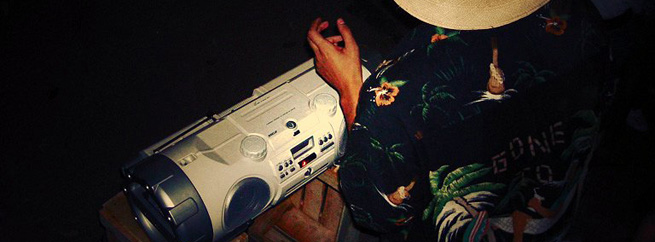
Matias Aguayo’s Bumbumbox of Joy
18 August, 2011If you’re sick and tired of club culture, VIP access, huge entrance fees, even larger drink prices and designated times in which you’re able to party, then maybe you should check out Bumbumbox. Maybe you could even start a Bumbumbox of your own. That’s what Matias Aguayo, Eugenia Caloso, Pablo Castoldi and Gary Pimiento did.
Matias Aguayo moved to Buenos Aires in 2003, seduced by the vibrant underground music scene. It was a scene that changed drastically in December 2004 when 200 people died in the República Cromagnon nightclub. Following this health and safety precautions and legislation for nightclubs took on new strict levels and this caused many of the smaller clubs to close down.
I met Mathias and Pablo in Newcastle [upon Tyne, England] where they were giving a talk on the Bumbumbox project after performing the previous day, all as part of Vamos festival.
Pablo talked of a club in Buenos Aires whose floor was covered in hay – it was one of the club’s gimmicks. Unsurprisingly, this was one of the first clubs to be affected by the new restrictions, and many more followed.
One weekend, sick of listening to the same ol’ music in the mainstream clubs, which were the only ones that survived, they decided to take a stereo onto the street and dance there. Soon, a crowd built up, and would continue growing through the night. On the way home, the group decided that this wasn’t just going to be a one-off. Bumbumbox was born!
The beauty of the Bumbumbox idea was that it was not illegal. Occasionally if they were making noise the police would ask them to move on, but nothing more. They had truly found a unique way in which to dance with friends and listen to music they liked, an idea which a lot of other people also liked, leading to Bumbumbox gaining a decent following in Buenos Aires, and invitations to take their boombox to other countries.
Crucial to this success has been the Bumbumbox sound. In the same way that punk music with it’s raw, direct sound came from bands playing in tiny backrooms of pubs and clubs, and stadium rock’s use of simple chord patterns and audience participation was perfect for it’s location, Bumbumbox needed to find a sound that would work coming from a boombox on the street and (crucially) would get people dancing.
Aguayo was already a prominent DJ at this point and, along with his friends, would make 30 minute DJ mixes that would be played on an mp3 player hooked up to the boombox. Over time he learnt to refine the sound, mainly through ‘trial and error’ until understanding what songs would work best in this medium. In their Newcastle talk, Matias said how he quickly found out that dance music made for clubs, with it’s big thumping beats, doesn’t always work for Bumbumbox, whereas music made for Bumbumbox always worked in clubs. This is all to do with it’s dynamics. There needs to be some kind of constant beat to keep people dancing but there also needs to be bursts of melody, flourishes of beats or recurring themes to get people’s attentions.
These traits are reflected by the music put out by Cómeme, the label set-up by Aguayo and Pablo to release music made especially for Bumbumbox. As well as records by Aguayo it has released work by Rebolledo, Diegors (listen to one of his tracks below) and Ana Helder, among others.
[soundcloud url=”http://soundcloud.com/comeme/diegors-unga”]
It is quite clear that the ideas behind Bumbumbox and Cómeme are good ones, and ones that people can embrace, but the real appeal of the projects has been the passion in which everyone has involved into making them as fun as possible. Just take a look at Cómeme’s videos or the artwork for their releases and you’ll release that these are people simply enjoying themselves!
To finish, here’s the great video for Rebolledo’s “Guerrero”:
You can listen to music from Bumbumbox at soundcloud.com/bumbumbox and www.musicacomeme.com, and watch videos at www.youtube.com/user/bumbumbox
Follow Sounds and Colours: Facebook / Twitter / Instagram / Mixcloud / Soundcloud / Bandcamp
Subscribe to the Sounds and Colours Newsletter for regular updates, news and competitions bringing the best of Latin American culture direct to your Inbox.

